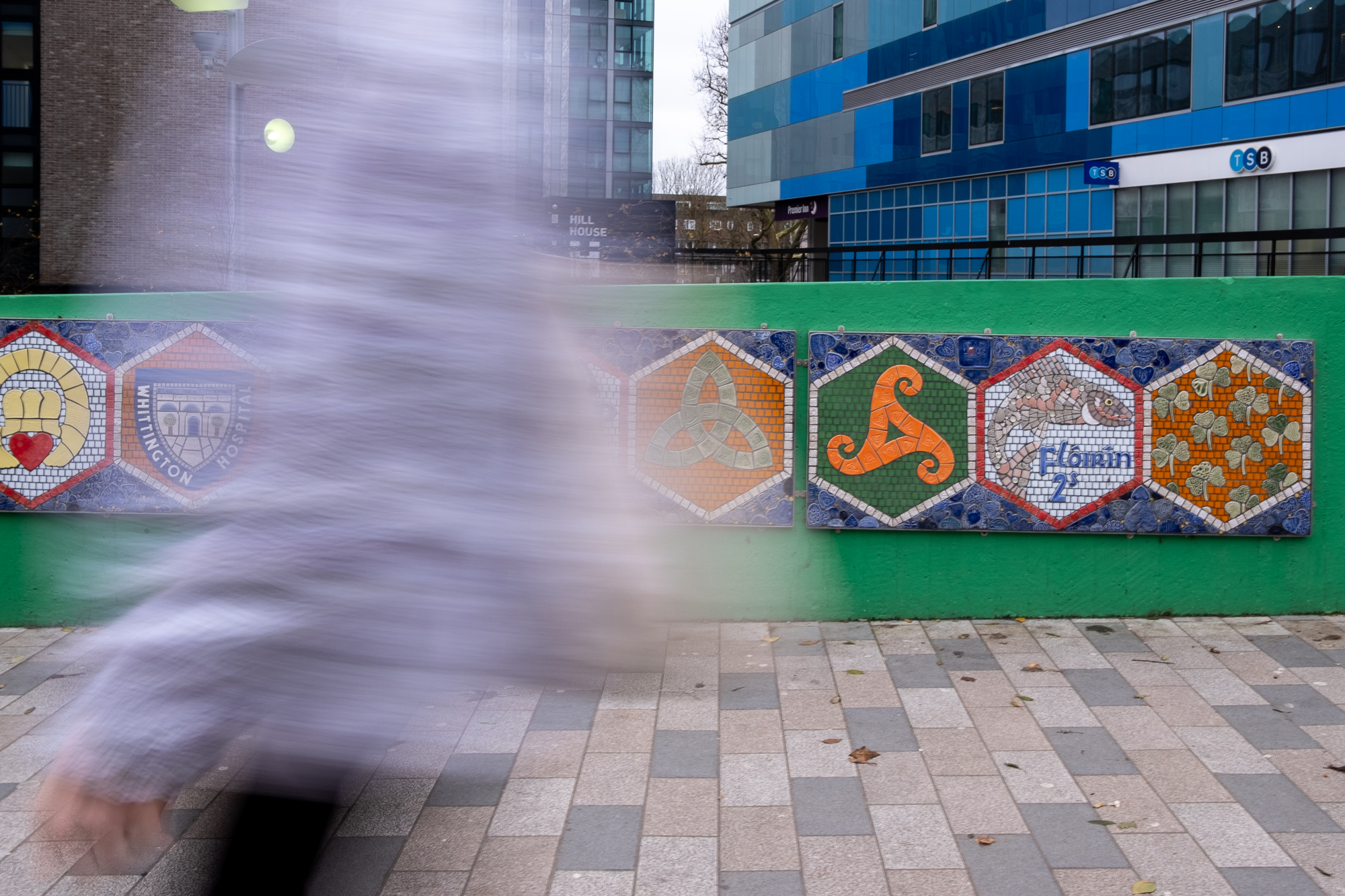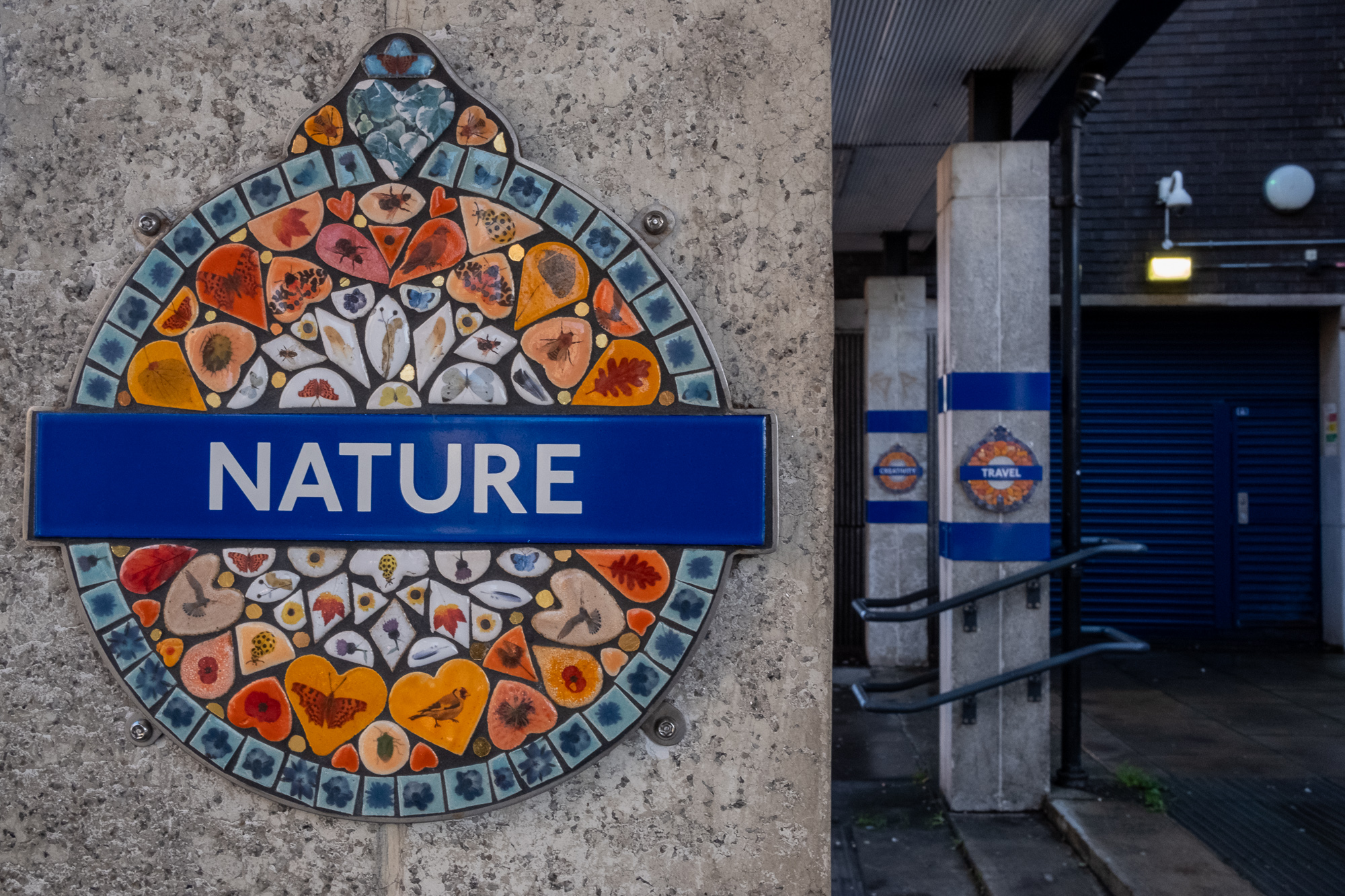Maud Milton | Artyface
︎
community artist
London, UK
community artist
London, UK


THIS WOULD BE my second time at Trinity Buoy Wharf, a creative hub that sits where the River Thames meets the River Lea. But this time it was to visit Maud Milton, a community artist who has been creating high quality, legacy public art with her organisation, Artyface since 1999. As we spoke I also found out that she is one of the longest standing tenants of Trinity Buoy Wharf, having been there for over 18 years!
At the time of our meeting, Maud was in the midst of creating ten panels for a trail, commission by the Bedford Road Association, that highlighted the local wildlife and lost words. While she assembled each mosaic, gluing them down piece by piece, I got the chance to speak to her about her art practice and her experience running Artyface.




Q: Tell me about your journey to making public art and setting up Artyface.
I graduated with a ceramics degree and have always been interested in public art and working for the community. One of my first jobs was working with kids at a primary school in Caerphilly in Wales, to create art for a park. It’s extremely fulfilling to know that the art will live on for a long time.
I graduated with a ceramics degree and have always been interested in public art and working for the community. One of my first jobs was working with kids at a primary school in Caerphilly in Wales, to create art for a park. It’s extremely fulfilling to know that the art will live on for a long time.
So, I decided to set up Artyface in London in 1999, and for me, community involvement is key. When you get the community involved, the art work is also less likely to get vandalised. Our mosaic projects are multicultural, multigenerational and inclusive, and we have worked with one-year-olds to people in their nineties, and also with people who struggle with mental health or addiction issues.


Q: How many people are involved in Artyface? And as the founder, what’s your role?
I’m the lead artist, but our team is fundamental to what we do. Many of them are artists in their own right, and we have a group of local volunteers and trainees that make up the team. Some have been with me for many years, like Catherine Clark, who is a retired teacher, and most recently, Esme, who has been helping me with video. They’re all amazing.
Truth be told, I’m probably a workaholic, which is necessary as I do all the essential background work and business management. From getting funding, filling out applications and getting permissions to use walls, overseeing the making of the tiles and orchestrating the workshops. There’s always so much to do. Sometimes I wish I could clone myself!
I’m the lead artist, but our team is fundamental to what we do. Many of them are artists in their own right, and we have a group of local volunteers and trainees that make up the team. Some have been with me for many years, like Catherine Clark, who is a retired teacher, and most recently, Esme, who has been helping me with video. They’re all amazing.
Truth be told, I’m probably a workaholic, which is necessary as I do all the essential background work and business management. From getting funding, filling out applications and getting permissions to use walls, overseeing the making of the tiles and orchestrating the workshops. There’s always so much to do. Sometimes I wish I could clone myself!



Q: Why did you decide to do mosaics?
It’s simple, really. With traditional ceramics, the community can’t really see the colours and also the clay won’t wait – once it’s rolled out, it’s non-stop and there’s no possibility of intermittent days. Also, it’s brutal work laying a clay mural down as one vast piece and then cutting it up and patterning it. Mosaics made sense because they’re more manageable and we could get the community involved.
During the 2020 covid lockdown, we created tile boxes and delivered them to households (at a safe distance, of course!). We wanted to encourage people to exercise their creativity at home. We asked the community to find items in their homes to press into wet clay tiles and make their mark. These tiles were collected, fired and glazed and went into making the roundels for Walthamstow Central, St James Street, Thornton Heath and Selhurst stations.
It’s simple, really. With traditional ceramics, the community can’t really see the colours and also the clay won’t wait – once it’s rolled out, it’s non-stop and there’s no possibility of intermittent days. Also, it’s brutal work laying a clay mural down as one vast piece and then cutting it up and patterning it. Mosaics made sense because they’re more manageable and we could get the community involved.
During the 2020 covid lockdown, we created tile boxes and delivered them to households (at a safe distance, of course!). We wanted to encourage people to exercise their creativity at home. We asked the community to find items in their homes to press into wet clay tiles and make their mark. These tiles were collected, fired and glazed and went into making the roundels for Walthamstow Central, St James Street, Thornton Heath and Selhurst stations.




Q: I love your roundels - how did this project come about?
Our most recent public transport project is with Arriva Trains London and TFL (Transport For London). We made 1 large roundel and 15 small ones for Blackhorse Road. This took 3 years to complete, working with station staff and students from the community.
Our most recent public transport project is with Arriva Trains London and TFL (Transport For London). We made 1 large roundel and 15 small ones for Blackhorse Road. This took 3 years to complete, working with station staff and students from the community.
I’m grateful for how our London Overground partnership with Arriva has grown to let us work with over 8,000 people in the community to beautify the stations on the London Overground. I’m proud that we have about 30 roundels up at 12 stations, with 2 Birmingham roundels installed at Perry Barr and University stations, as part of the Commonwealth Games legacy. Four more just went up at Worthing station, by the seaside in West Sussex. Currently there are some exciting developments for some London stations, to be announced soon!




Q: What are some of the challenges you face as you run Artyface?
One that no one really thinks about is the weather. It’s impossible to install any of our artwork when the temperature is 6 degrees and below, which is why our projects take over 6 months to finish.
To be honest, the artist’s life is not glamorous, especially when you’re struggling to have enough money to heat the studio. And the work can get lonely. I’m usually the one doing all the “boring” administrative stuff. It took me awhile to find my balance. Early on, I didn’t want to disappoint people, I wanted to attract clients and make the community proud. But it has gotten better over time. For Artyface, decision-making can often stall our projects, making it difficult to get funding or permissions to use walls.
One that no one really thinks about is the weather. It’s impossible to install any of our artwork when the temperature is 6 degrees and below, which is why our projects take over 6 months to finish.
To be honest, the artist’s life is not glamorous, especially when you’re struggling to have enough money to heat the studio. And the work can get lonely. I’m usually the one doing all the “boring” administrative stuff. It took me awhile to find my balance. Early on, I didn’t want to disappoint people, I wanted to attract clients and make the community proud. But it has gotten better over time. For Artyface, decision-making can often stall our projects, making it difficult to get funding or permissions to use walls.


Q: And what is the best part about what you do?
Seeing how people react to the art work keeps me going. I get emails, selfies and photos from all ages posing with the artwork. Thank you to everyone who is interested in what we do!
Seeing how people react to the art work keeps me going. I get emails, selfies and photos from all ages posing with the artwork. Thank you to everyone who is interested in what we do!
And, our work is also fun! I am a doer and a maker and it’s easy for me to lose myself in the creative process. It feels like play, a flow, almost zen-like and I lose track of time. I also love that I get to work with our amazing team.
“I love how democratic and inclusive our work is.
We’re bringing the local community together to make art that lasts forever.”
We’re bringing the local community together to make art that lasts forever.”




After speaking to Maud about the amazing work of Artyface, I spent my free time over the next few days hunting down and visiting her public art in various parts of London, with many in Walthamstow area (E17). I can imagine how spotting one of her lovely roundels on the Overground during your daily commute could brighten up your day.
I especially loved how her
mosaics at the Walthamstow Village Gateway, which transformed the stretch of wall into a gallery that featured the local wildlife and local artists. Stamped into the mosaics is a message that these tiles were made by primary school students in the community. Maud and her team at Artyface do the hard but essential work of championing community involvement in creating art that unites people and makes the city beautiful. It makes me wonder about the great potential of community-driven art in other cities around the world.
Follow:
Maud Milton | Artyface
https://artyface.co.uk
https://www.instagram.com/maudmilton
︎
Visited December 2023, published December 2024.
Maud Milton | Artyface
https://artyface.co.uk
https://www.instagram.com/maudmilton
︎
Visited December 2023, published December 2024.